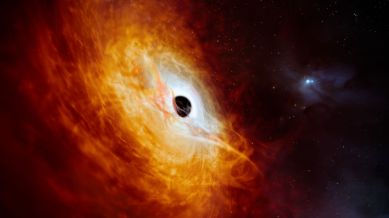Brightest object in the universe is a quasar that eats a ‘sun per day’
The quasar is more than 500 trillion times brighter than the Sun and the supermassive black hole at its center has a massive appetite, eating equivalent of the mass of the Sun every day.

The European Southern Observatory on Monday announced the characterisation of an extremely bright quasar that is not only the brightest of its kind but also the most luminous object ever observed in space. The black hole within this record-breaking celestial object consumes the mass of our Sun every day.
Quasars are the extremely active and bright cores of some distant galaxies and are powered by supermassive black holes. Supermassive black holes grow by consuming matter that is sucked in by their immensely strong gravity. The one at the centre of the newly-discovered quasar is the fastest growing black hole discovered to date. The quasar’s official name is J0529-4351 and it is so far away from our planet that its light took more than 12 billion years to reach us. To get an idea of how far away that is, watch this video.
“We have discovered the fastest-growing black hole known to date. It has a mass of 17 billion Suns, and eats just over a Sun per day. This makes it the most luminous object in the known Universe,” said Christian Wolf, lead author of a study on the black hole in Nature Astronomy, in a press statement.
Black holes themselves do not emit any light or energy but the material they are consuming does. The matter being pulled into the extremely bright quasar emits so much energy that it is over 500 trillion times more luminous than the Sun. Despite being extremely bright, energetic and massive, this quasar was “hiding in plain sight,” according to the researchers who discovered it.
“It is a surprise that it has remained unknown until today when we already know about a million less impressive quasars. It has literally been staring us in the face until now,” added co-author Christopher Onken. J0529-4351 is present in images taken by the ESO Schmidt Southern Sky Survey dating back to 1980, but it was not recognised as a quasar until much later.